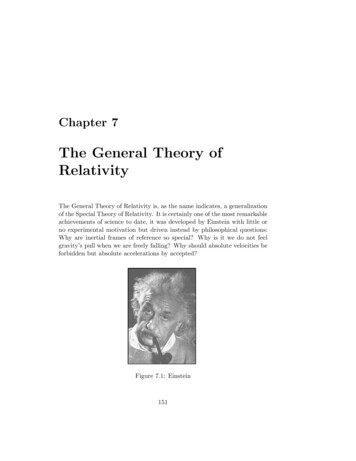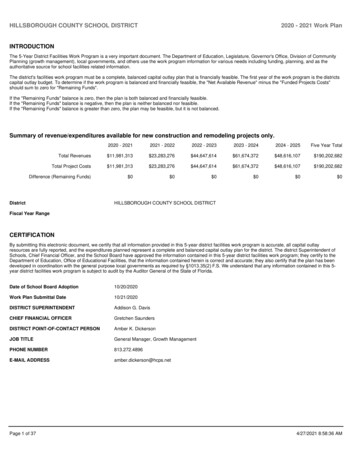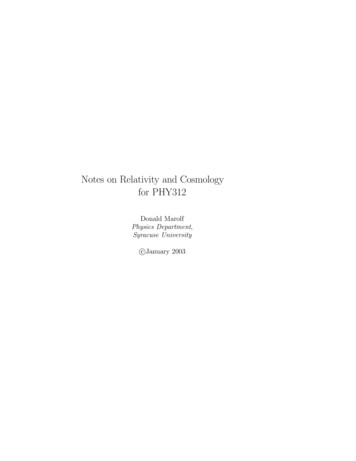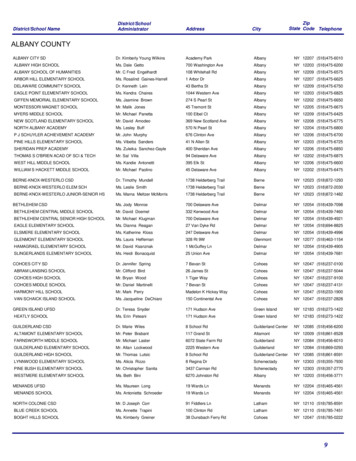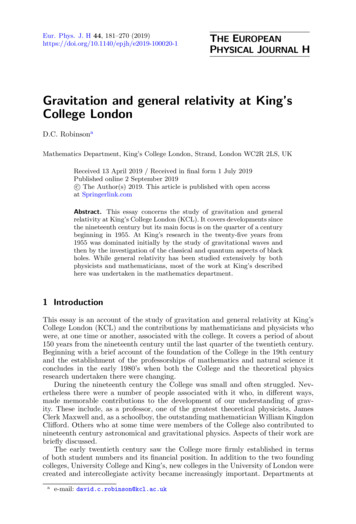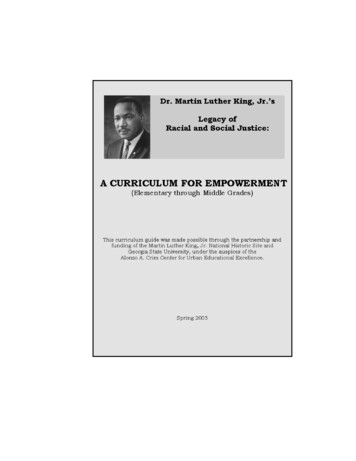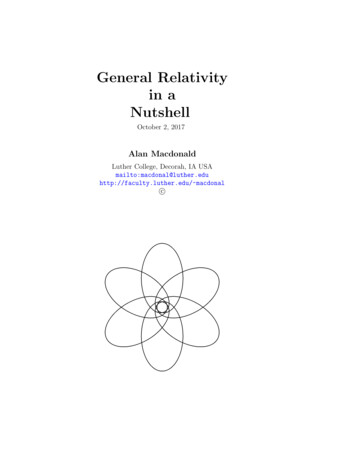
Transcription
General Relativityin aNutshellOctober 2, 2017Alan MacdonaldLuther College, Decorah, IA .edu/ macdonalc
To Ellen
“The magic of this theory will hardly fail to impose itself on anybodywho has truly understood it.”Albert Einstein, 1915“The foundation of general relativity appeared to me then [1915],and it still does, the greatest feat of human thinking about Nature,the most amazing combination of philosophical penetration, physicalintuition, and mathematical skill.”Max Born, 1955“One of the principal objects of theoretical research in any department of knowledge is to find the point of view from which the subjectappears in its greatest simplicity.”Josiah Willard Gibbs“There is a widespread indifference to attempts to put accepted theories on better logical foundations and to clarify their experimentalbasis, an indifference occasionally amounting to hostility. I am concerned with the effects of our neglect of foundations on the education of scientists. It is plain that the clearer the teacher, the moretransparent his logic, the fewer and more decisive the number of experiments to be examined in detail, the faster will the pupil learnand the surer and sounder will be his grasp of the subject.”Sir Hermann Bondi“Things should be made as simple as possible, but not simpler.”Albert Einstein
ContentsContentsvPreface1 Flat Spacetimes1.1 Spacetimes . . . . . . . . . .1.2 The Inertial Frame Postulate1.3 The Metric Postulate . . . . .1.4 The Geodesic Postulate . . .vii.1148152 Curved Spacetimes2.1 Newton’s theory of gravity . . . . .2.2 The Key to General Relativity . .2.3 The Local Inertial Frame Postulate2.4 The Metric Postulate . . . . . . . .2.5 The Geodesic Postulate . . . . . .2.6 The Field Equation . . . . . . . . .171719232730333 Spherically Symmetric Spacetimes3.1 Stellar Evolution . . . . . . . . . .3.2 Schwarzschild Metric . . . . . . . .3.3 Solar System Tests . . . . . . . . .3.4 Kerr Spacetimes . . . . . . . . . .3.5 Extreme Binary Systems . . . . . .3.6 Black Holes . . . . . . . . . . . . .393942475255574 Cosmological Spacetimes4.1 Our Universe I . . . . . . . .4.2 The Robertson-Walker Metric4.3 Expansion Effects . . . . . . .4.4 Our Universe II . . . . . . . .4.5 General Relativity Today . .616165676977.A Appendix.79Index101v
vi
PrefaceThe purpose of this little book is to provide a clear and careful account of generalrelativity with a minimum of mathematics. The book has fewer prerequisitesthan other texts, and less mathematics is developed. The prerequisites are singlevariable calculus, a few basic facts about partial derivatives and line integrals,and a little matrix algebra. A little knowledge of physics is useful but notessential. The algebra of tensors plays only a minor role.1 (Similarly, manyelementary differential geometry texts develop the intrinsic geometry of curvedsurfaces without using tensors.)Despite the book’s brevity and modest prerequisites, it is a serious introduction to the theory and applications of general relativity which demands carefulstudy. It can be used as a textbook for general relativity or as an adjunct tostandard texts. It is also suitable for self-study by more advanced students.All this should make general relativity available to a wider audience thanbefore. A well prepared sophomore can learn about exciting current topics suchas curved spacetime, black holes, the big bang, dark energy, and the acceleratinguniverse.Chapter 1 is a self-contained introduction to those parts of special relativitywe require for general relativity. We take a nonstandard approach to the metric,analogous to the standard approach to the metric in Euclidean geometry. Ingeometry, distance is first understood geometrically, independently of any coordinate system. If coordinates are introduced, then distances can be expressed interms of coordinate differences: s2 x2 y 2 . The formula is important,but the geometric meaning of the distance is fundamental.Analogously, we define the spacetime interval of special relativity physically,independently of any coordinate system. If inertial frame coordinates are introduced, then the interval can be expressed in terms of coordinate differences: s2 t2 x2 y 2 z 2 . The formula is important, but the physicalmeaning of the interval is fundamental. This approach to the metric provideseasier access to and deeper understanding of special and general relativity, andfacilitates the transition from special to general relativity.1 The notion of covariant and contravariant indices is developed and used in one page ofthe text.vii
Chapter 2 introduces the four fundamental principles of general relativityas postulates. The purpose of the postulates is not to achieve rigor – whichis neither desirable nor possible in a book at this level – but to state clearlythe principles, and to exhibit clearly the relationship to special relativity andthe analogy with surfaces. The first three principles are expressed in termsof local inertial frames, which tells us their physical meaning. They are thentranslated to global coordinates, which is necessary for calculations. The fourthprinciple, the field equation, is then motivated and stated. Finally, an interestingconsequence of the field equation relating curvatures and density is obtained.The first two chapters systematically exploit the mathematical analogy whichled to general relativity: a curved spacetime is to a flat spacetime as a curvedsurface is to a flat surface. Before introducing a spacetime concept, its analogfor surfaces is presented. This is not a new idea, but it is used here more systematically than elsewhere. For example, when the metric ds of general relativityis introduced, the reader has already seen a metric in three other contexts.Chapter 3 solves the field equation for a spherically symmetric spacetime toobtain the Schwarzschild metric. The geodesic equations are then solved andapplied to the classical solar system tests of general relativity. There is a sectionon the Kerr metric, which includes gravitomagnetism and the Gravity Probe Bexperiment. The chapter closes with sections on the double pulsar and blackholes. In this chapter, as elsewhere, I have tried to provide the cleanest possiblecalculations.Chapter 4 applies general relativity to cosmology. We obtain the RobertsonWalker metric in an elementary manner without the field equation. We reviewthe evidence for a spatially flat universe with a cosmological constant. Wethen apply the field equation with a cosmological constant to a spatially flatRobertson-Walker spacetime. The solution is given in closed form. Recentastronomical data allow us to specify all parameters in the solution, giving thenew “standard model” of the universe with dark matter, dark energy, and anaccelerating expansion.Many recent spectacular astronomical discoveries and observations are relevant to general relativity. They are described at appropriate places in thebook.Some tedious (but always straightforward) calculations have been omitted.They are best carried out with a computer algebra system. Some material hasbeen placed in about 20 pages of appendices to keep the main line of developmentvisible. They may be omitted without loss of anything essential. Appendix 1gives the values of various physical constants. Appendix 2 contains several approximation formulas used in the text.viii
Chapter 1Flat Spacetimes1.1SpacetimesThe general theory of relativity is our best theory of space, time, and gravity. Albert Einsteincreated the theory during the decade followingthe publication of his special theory of relativity in 1905. The special theory is a theory ofspace and time which does not take gravity intoaccount. The general theory, published in 1915,generalizes the special theory to include gravity.It is commonly felt to be the most beautiful ofall physical theories.We will explore many fascinating aspects ofrelativity, such as the behavior of moving clocks,curved spacetimes, Einstein’s field equation, the Fig. 1.1:perihelion advance of Mercury, black holes, the 1879-1955.big bang, the accelerating expansion of the universe, and dark energy. Let us begin!1Albert Einstein,
1 Flat Spacetimes1.1 SpacetimesDefinitions. We give definitions of three fundamental concepts used throughout this book: event, spacetime, and worldline.Event. In geometry the fundamental entities are points. A point is aspecific place. In relativity the fundamental entities are events. An event isa specific time and place. It has neither temporal nor spatial extension. Forexample, the collision of two particles is an event. To be present at the event,you must be at the right place at the right time.Spacetime. A flat or curved surface is a set of points. (We shall preferthe term “flat surface” to “plane”.) Similarly, a spacetime is a set of events.Chapter 3 examines the spacetime around the Sun. We will study the motionof planets and light in the spacetime. Chapter 4 examines a spacetime for theentire universe! We will study the origin and evolution of the universe.A flat spacetime is a spacetime without significant gravity. Special relativitydescribes flat spacetimes. A curved spacetime is a spacetime with significantgravity. General relativity describes curved spacetimes.There is nothing mysterious about the words “flat” or “curved” attached toa spacetime. They are chosen because of a remarkable analogy, already hintedat, concerning the mathematical description of a spacetime: a curved spacetimeis to a flat spacetime as a curved surface is to a flat surface. The analogy willbe a major theme of this book: we will use our intuitive understanding of flatand curved surfaces to guide our understanding of flat and curved spacetimes.Worldline. A curve in a surface is a continuous succession of points in thesurface. A worldline in a spacetime is a continuous succession of events in thespacetime. A moving particle or a pulse of light emitted in a single direction ispresent at a continuous succession of events, its worldline. Even if a particle isat rest, time passes, and the particle has a worldline. A planet has a worldlinein the curved spacetime around the Sun. Note that if the planet returns to aspecific point in space during its orbit, then it does not return to the same eventin the spacetime, as it returns at a later time.Time. Relativity theory contradicts everyday views of time. The mostdirect illustration of this is the Hafele-Keating experiment, which we now describe.The length of a curve between two given points depends on the curve. Similarly, the time between two given events measured by a clock moving betweenthe events depends on the clock’s worldline! In 1971 J. C. Hafele and R. Keatingbrought two atomic clocks together, placed one of them in an airplane whichcircled the Earth, and then brought the clocks together again. Thus the clockshad different worldlines between the event of their separation and the eventof their reunion. The clocks measured different times between the two events.The difference was small, about 10 7 sec, but was well within the ability of theclocks to measure. There is no doubt that the effect is real.We shall see that relativity predicts the measured difference. We shall alsosee that relativity predicts large differences between clocks whose relative speedis close to that of light.2
1 Flat Spacetimes1.1 SpacetimesThe best answer to the question “How can the clocks in the experiment possibly disagree?” is the question “Why should they agree?” After all, the clockswere not connected. According to everyday ideas they should agree becausethere is a universal time, common to all observers. It is the duty of clocks to report this time. The concept of a universal time was abstracted from experiencewith small speeds (compared to that of light) and clocks of ordinary accuracy,where it is nearly valid. The concept permeates our daily lives; there are clockseverywhere telling us the time. However, the Hafele-Keating experiment showsthat there is no universal time. Time, like distance, is route dependent.Since clocks on different worldlines between two events measure differenttimes between the events, we cannot speak of the time between two events. Butclocks traveling together between the events will measure the same time betweenthe events. (Unless some adverse physical condition affects a clock’s rate.) Thuswe can speak of the time along a given worldline between the events.The word “clock” here must be understood in the general sense of any physical process, e.g., the vibrations of a tuning fork, radioactive decays, or the agingof an organism. Twins, each remaining close to one of the clocks during theHafele-Keating experiment, would age according to their clock. They wouldthus be of slightly different ages when reunited.The next three sections put forward three postulates for special relativity.The inertial frame postulate asserts that certain natural coordinate systems,called inertial frames, exist for a flat spacetime. The metric postulate assertsa universal light speed and a slowing of clocks moving in inertial frames. Thegeodesic postulate asserts that inertial particles (which we will define) and lightmove in a straight line at constant speed in inertial frames.Imagine two dimensional beings living in a flat surface. These surfacedwellers can no more imagine leaving their two spatial dimensions than wecan imagine leaving our three spatial dimensions. Before introducing a postulate for a flat spacetime, we introduce the analogous postulate formulated bysurface dwellers for a flat surface. The postulates for a flat spacetime use a timedimension, but those for a flat surface do not.3
1 Flat Spacetimes1.21.2 The Inertial Frame PostulateThe Inertial Frame PostulatePlanar Frames. Surface dwellers find it useful to label the points of their flatsurface with coordinates. They construct, using identical rigid rods, a squaregrid and assign rectangular coordinates (x, y) to the nodes of the grid in theusual way. See Fig. 1.2. Surface dwellers call the coordinate system a planarframe. Fig. 1.3 shows the axes of two different planar frames.Fig. 1.2: A planar frame.Fig. 1.3: Two planar frames.The Planar Frame Postulate for a Flat SurfaceA planar frame can be constructed with any point P as origin andwith any orientation.Inertial Frames. Imagine that you are an astronaut in interstellar space, where gravity is insignificant.If your rocket is not firing and your ship is not spinning,then you will feel no forces acting on you and you canfloat freely in your cabin. If your spaceship is accelerating, then you will feel a force pushing you back againstyour seat. If the ship turns to the left, then you will feela force to the right. If the ship is spinning, you will feela force outward from the axis of spin. Call these forcesinertial forces.Accelerometers measure inertial forces. Fig. 1.4shows a simple accelerometer consisting of a weight heldat the center of a cubical frame by identical springs. Inertial forces cause the weight to move from the center.An object which experiences no inertial forces iscalled an inertial object.Fig. 1.4: A simple accelerometer. Acceleration causes the weightto move from the center.It is useful to label the events in a flat spacetime with coordinates (t, x, y, z).The coordinates specify when (the t coordinate) and where (the (x, y, z) coordinates) the event occurs, i.e., they completely specify the location of the eventin the spacetime. We now describe how to attach coordinates to events. Theprocedure is idealized, but it gives a clear physical meaning to the coordinates.4
1 Flat Spacetimes1.2 The Inertial Frame PostulateTo specify where an event occurs, construct, using identical rigid rods, an inertial cubical lattice. SeeFig. 1.5. Assign rectangular coordinates (x, y, z) to thenodes of the lattice in the usual way. To specify when anevent occurs, place a clock at each node of the lattice.Then the times of events at a given node can be specified by reading the clock at that node. But to comparemeaningfully the times of events at different nodes, theclocks must be in some sense synchronized. As we shallsee soon, this is not a trivial matter. (Remember, there Fig. 1.5: An inertialis no universal time.) For now, assume that the clocks lattice.have been synchronized. Then specify when an eventoccurs by using the time, t, on the clock at the node nearest the event.The four dimensional coordinate system (t, x, y, z) obtained in this way froman inertial cubical lattice with synchronized clocks is called an inertial frame.The event (0, 0, 0, 0) is the origin of the inertial frame.If you are an inertial object then you can construct an inertial frame in whichyou are at rest. If fact, you can do this in many ways:The Inertial Frame Postulate for a Flat SpacetimeAn inertial frame can be constructed with any event E as origin,any inertial object at rest in it, and any spatial orientation.If we suppress one or two of the spatial coordinatesof an inertial frame, then we can draw a spacetime diagram and depict worldlines. For example, Fig. 1.6shows the worldlines of two particles. One is at rest onthe x-axis and the other moves away from x 0 andthen returns more slowly.Fig. 1.6: Worldlines.Exercise 1.1. Show that the worldline of an object moving along the x-axisat constant speed v is a straight line with slope v.1Exercise 1.2. Describe the worldline of an object moving in a circle in thez 0 plane at constant speed. You need three dimensions for this, two of spaceand one of time.1 Spacetime diagrams are usually constructed with t as the vertical axis and x the horizontalaxis. Then the slope is 1/v.5
1 Flat Spacetimes1.2 The Inertial Frame PostulateSynchronization. We return to the matter of synchronizing the clocks ofan inertial frame. We can directly compare side-by-side clocks to see if theyare synchronized. But what does it mean to say that separated clocks aresynchronized? Einstein realized that the answer to this question is not given tous by Nature; rather, it must be answered with a definition.Exercise 1.3. Why not simply bring the clocks together, synchronize them,move them to the nodes of the lattice, and call them synchronized?We might try the following definition. Send a signal from a node P of thelattice at time tP according to the clock at P . Let it arrive at a node Q ofthe lattice at time tQ according to the clock at Q. Let the distance betweenthe nodes be D and the speed of the signal be v. Say that the clocks aresynchronized iftQ tP D/v.(1.1)Intuitively, the term D/v compensates for the time it takes the signal to get toQ. This definition is flawed because it contains a logical circle. For v is definedby a rearrangement of Eq. (1.1): v D/(tQ tP ). Synchronized clocks cannotbe defined using v because synchronized clocks are needed to define v.We adopt the following definition, essentially due to Einstein. Emit a pulseof light from a node P at time tP according to the clock at P . Let it arrive at anode Q at time tQ according to the clock at Q. Similarly, emit a pulse of lightfrom Q at time t0Q and let it arrive at P at t0P . The clocks are synchronized iftQ tP t0P t0Q ,(1.2)i.e., if the times in the two directions are equal.Reformulating the definition makes it more transparent. If the pulse fromQ to P is the reflection of the pulse from P to Q, then t0Q tQ in Eq. (1.2).Let 2T be the round trip time: 2T t0P tP . Substitute into Eq. (1.2):tQ tP T ;(1.3)the clocks are synchronized if the pulse arrives at Q in half the time it takes forthe round trip.Exercise 1.4. Explain why Eq. (1.2) is a satisfactory definition but Eq.(1.1) is not.There is a tacit assumption in the definition of synchronized clocks that thetwo sides of Eq. (1.2) do not depend on the times that the pulses are sent:Emit pulses of light from a node R at times tR and t0R accordingto a clock at R. Let them arrive at a node S at times tS and t0Saccording to a clock at S. Thent0S t0R tS tR .(1.4)With this assumption we can be sure that synchronized clocks will remain so.Exercise 1.5. Show that with the assumption Eq. (1.4), T in Eq. (1.3) isindependent of the time the pulse is sent.6
1 Flat Spacetimes1.2 The Inertial Frame PostulateThe inertial frame postulate asserts in part that clocks in an inertial latticecan be synchronized according to the definition Eq. (1.2), or, in P. W. Bridgeman’s descriptive phrase, we can “spread time over space”. Appendix 3 provesthis with the aid of an auxiliary assumption.Redshifts. A rearrangement of Eq. (1.4) gives so se ,(1.5)where so t0S tS is the time between the observation of the pulses at S and se t0R tR is the time between the emission of the pulses at R. (We use srather than t to conform to notation used later in more general situations.) Ifa clock at R emits pulses of light at regular intervals to S, then Eq. (1.5) statesthat an observer at S sees (actually sees) the clock at R going at the same rateas his clock. Of course, the observer at S will see all physical processes at Rproceed at the same rate they do at S.We will encounter situations in which so 6 se . Define the redshiftz so 1. se(1.6)Equations (1.4) and (1.5) correspond to z 0. If, for example, z 1 ( so / se 2), then the observer at S would see clocks at R, and all other physicalprocesses at R, proceed at half the rate they do at S.In Exercise 1.6 we shall see that Eq. (1.5) is violated, i.e., z 6 0, if theemitter and observer are in relative motion in a flat spacetime. This is calleda Doppler redshift. Later we shall see two other kinds of redshift: gravitationalredshifts in Sec. 2.2 and expansion redshifts in Sec. 4.1. The three types ofredshifts have different physical origins and so must be carefully distinguished.Redshifts are often expressed in terms of frequencies. If the two “pulses”of light in Eq. (1.6) are successive wavecrests of light emitted at frequencyfe ( se ) 1 and observed at frequency fo ( so ) 1 , then the equation canbe writtenfe 1.(1.7)z fo7
1 Flat Spacetimes1.31.3 The Metric PostulateThe Metric PostulateFlat Surface Metric. Let P and Q be points in a flat surface. Different curvesbetween the points have different lengths. But surface dwellers single out thestraight line distance s and call it the proper distance between the points.This definition of proper distance is in geometric terms, without using coordinates. If a planar frame is introduced, then the Pythagorean theorem gives asimple formula for s:The Metric Postulate for a Flat SurfaceLet s be the proper distance between two points. Let the pointshave coordinate differences ( x, y) in a planar frame. Then s2 x2 y 2 .(1.8)Here s2 means ( s)2 , x2 means ( x)2 , etc.The coordinate differences x and y betweenP and Q are different in different planar frames. SeeFig. 1.7. However, the particular combination of thedifferences in Eq. (1.8) will always produce s. Neither x nor y alone has a geometric significance.Together they do: they determine s, which has adirect geometric significance, independent of any coordinate system.Flat Spacetime Metric. Let E and F be1.7: s2 x2 events in a flat spacetime. There is a distance-like Fig. y 2 x̄2 ȳ 2 .quantity s between E and F , called the intervalbetween them. The definition of s in a flat spacetime is more complicated than in a flat surface, because there are three ways inwhich events can be, we say, separated : If E and F can be on the worldline of a pulse of light, they are lightlikeseparated. Then define s 0 for E and F . (The reason for this peculiardefinition will become clear later.) If E and F can be on the worldline of an inertial clock, they are timelikeseparated. Then define s to be the time between the events measuredby the inertial clock. This is the proper time between E and F . (Clockson other worldlines between the events will measure different times.) If E and F can be simultaneously at the ends of an inertial rod – simultaneously in the sense that light flashes emitted at E and F reach the centerof the rod simultaneously – they are spacelike separated. Then define s to be the length the rod. (The reason for the absolute value will becomeclear in Eq. (1.12).) This is the proper distance between E and F .This definition of the spacetime interval s just given is in physical terms,without using coordinates. If an inertial frame is introduced, then the metricpostulate for a flat spacetime asserts a simple formula for the interval:8
1 Flat Spacetimes1.3 The Metric PostulateThe Metric Postulate for a Flat SpacetimeLet s be the interval between two events. Let the events havecoordinate differences ( t, x, y, z) in an inertial frame. Then s2 t2 x2 y 2 z 2 .(1.9)The coordinate differences between E and F , including the time coordinatedifference, are different in different inertial frames. For example, suppose thatan inertial clock measures a proper time s between two events. In an inertialframe in which the clock is at rest, t s and x y z 0. Inan inertial frame in which the clock is moving, at least one of x, y, zwill not be zero. However, the particular combination of the differences in Eq.(1.9) will always produce s. None of the coordinate differences has a physicalsignificance independent of the particular inertial frame chosen. Together theydo: they determine s, which has a direct physical significance, independent ofany inertial frame.This shows that the joining of space and time into spacetime is not anartificial technical trick. Rather, in the words of Hermann Minkowski, whointroduced the spacetime concept in 1908, “Space by itself, and time by itself,are doomed to fade away into mere shadows, and only a kind of union of thetwo will preserve an independent reality.” The new relationship between spaceand time in special relativity is a radical change from the earlier view that spaceand time are independent.Minkowskian geometry, with mixed signs in its expression for the interval,Eq. (1.9), is different from Euclidean geometry. But it is a perfectly validgeometry, the geometry of a flat spacetime. It will, however, take you a whileto get used to it.Physical Meaning of the Metric Postulate. We discuss the physicalmeaning of the metric postulate formula, Eq. (1.9). We do not need the y- andz-coordinates for this, and so we use the formula in the form s2 t2 x2 .(1.10)We treat lightlike, timelike, and spacelike separated events individually.Lightlike Separated. By definition, a pulse of light can move betweenlightlike separated events, and s 0 for the events. From Eq. (1.10) thespeed of the pulse is x / t 1 . The metric postulate asserts that the speedc of light always has the value c 1 in all inertial frames.The assertion is that the speed is the same in all inertial frames; the actualvalue c 1 is a convention: Choose the distance light travels in one second– about 3 1010 cm – as the unit of distance. Call this one (light) second ofdistance. (You are probably familiar with a similar unit of distance – a lightyear.) Then 1 cm 3.3 10 11 sec. With this convention c 1, and all otherspeeds are expressed as a dimensionless fraction of the speed of light. Ordinarilythe fractions are very small. For example, 3 km/sec .00001.9
1 Flat Spacetimes1.3 The Metric PostulateSuppose Ellen is walking in a moving train. Her speed in a rest frame of thetrain (i.e., an inertial frame in which the train is at rest) is different from herspeed in a rest frame of the ground. But according to the metric postulate, apulse of light is different: it has the same speed in the two frames. You mustunderstand this difference to feel the full force of the postulate.Timelike Separated. By definition, an inertial clock can move betweentimelike separated events, and it measures the proper time s between theevents. The speed of the clock is v x / t . From Eq. (1.10),111 s ( t2 x2 ) 2 [1 ( x/ t)2 ] 2 t (1 v 2 ) 2 t.(1.11)Thus s t. This is called time dilation.Informally, “moving clocks run slowly”. Fig.1.8 shows the graph of the time dilation factor1 t/ s (1 v 2 ) 2 . For normal speeds, v isvery small, v 2 is even smaller, and so s t,1as expected. But as v 1, (1 v 2 ) 2 .Exercise 1.6. Investigate the Doppler redshift. A source of light pulses moves with speedv directly away from an observer at rest in aninertial frame. Let te be the time between theemission of pulses, and to be the time between Fig. 1.8: The time dilation fac1their reception by the observer.tor t/ s (1 v 2 ) 2 vs. v.a. Show that to te v te .b. Ignore time dilation in Eq. (1.6) by setting s t. Show that z vin this approximation.1c. Show that the exact formula is z [(1 v)/(1 v)] 2 1. Use the resultof part a.Spacelike Separated. By definition, the ends of an inertial rigid rod ofproper length s can be simultaneously present at spacelike separated events.Appendix 5 shows that t x and that the speed of the rod in I is v t/ x (that is not a typo).Exercise 1.7. Show that a calculation similar to Eq. (1.11) gives1 s (1 v 2 ) 2 x .(1.12)(Since s2 0 we must take the absolute value s .) Thus s x .Appendix 6 discusses a different phenomenon, called length contraction, ofmoving rods.10
1 Flat Spacetimes1.3 The Metric PostulateConnections. We have just seen that the physical meaning of the metric postulate i
\The magic of this theory will hardly fail to impose itself on anybody who has truly understood it." Albert Einstein, 1915 \The foundation of general relativity appeared to me then [1915], and it still does, the greatest feat of human thinking about Nature, the most a
